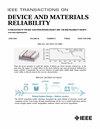Weak Snapback Silicon Controlled Rectifier ESD Device With Double Snapback Characteristics
IF 2.3
3区 工程技术
Q2 ENGINEERING, ELECTRICAL & ELECTRONIC
IEEE Transactions on Device and Materials Reliability
Pub Date : 2025-03-19
DOI:10.1109/TDMR.2025.3571056
引用次数: 0
Abstract
This paper investigates three Silicon Controlled Rectifier (SCR) devices employing different shunting methods to enhance the holding voltage and prevent latch-up. The operating principles of these devices are analyzed using equivalent circuits and two-dimensional (2D) device simulations, while the device performance is validated through Transmission Line Pulse (TLP) testing and curve tracer characterization. The Weak Snapback SCR (WSSCR), utilizing the third shunting method, achieves the highest holding voltage (Vh) of 7.12 V while maintaining a trigger voltage as low as 8.92 V, fully meeting the 5V ESD design requirements. Meanwhile, during high-temperature and long-pulse-width TLP testing, its Vh remains above 5.5V, meeting the latch-up immunity requirement. The WSSCR exhibits unique double-snapback characteristics. Such feature is explained by analyzing transient waveforms at various points during the TLP test and Technology Computer Aided Design (TCAD) simulations.具有双Snapback特性的弱Snapback硅控整流器ESD器件
本文研究了三种采用不同分流方法的可控硅整流器(SCR)器件,以提高保持电压和防止锁存。利用等效电路和二维(2D)器件仿真分析了这些器件的工作原理,同时通过传输线脉冲(TLP)测试和曲线示踪剂表征验证了器件性能。采用第三种分流方法的弱Snapback SCR (WSSCR)实现了7.12 V的最高保持电压(Vh),同时保持低至8.92 V的触发电压,完全满足5V ESD设计要求。同时,在高温、长脉宽TLP测试中,其Vh保持在5.5V以上,满足锁相抗扰度要求。WSSCR具有独特的双回吸特性。通过分析张力腿平台测试和技术计算机辅助设计(TCAD)模拟过程中各点的瞬态波形,可以解释这种特性。
本文章由计算机程序翻译,如有差异,请以英文原文为准。
求助全文
约1分钟内获得全文
求助全文
来源期刊

IEEE Transactions on Device and Materials Reliability
工程技术-工程:电子与电气
CiteScore
4.80
自引率
5.00%
发文量
71
审稿时长
6-12 weeks
期刊介绍:
The scope of the publication includes, but is not limited to Reliability of: Devices, Materials, Processes, Interfaces, Integrated Microsystems (including MEMS & Sensors), Transistors, Technology (CMOS, BiCMOS, etc.), Integrated Circuits (IC, SSI, MSI, LSI, ULSI, ELSI, etc.), Thin Film Transistor Applications. The measurement and understanding of the reliability of such entities at each phase, from the concept stage through research and development and into manufacturing scale-up, provides the overall database on the reliability of the devices, materials, processes, package and other necessities for the successful introduction of a product to market. This reliability database is the foundation for a quality product, which meets customer expectation. A product so developed has high reliability. High quality will be achieved because product weaknesses will have been found (root cause analysis) and designed out of the final product. This process of ever increasing reliability and quality will result in a superior product. In the end, reliability and quality are not one thing; but in a sense everything, which can be or has to be done to guarantee that the product successfully performs in the field under customer conditions. Our goal is to capture these advances. An additional objective is to focus cross fertilized communication in the state of the art of reliability of electronic materials and devices and provide fundamental understanding of basic phenomena that affect reliability. In addition, the publication is a forum for interdisciplinary studies on reliability. An overall goal is to provide leading edge/state of the art information, which is critically relevant to the creation of reliable products.
 求助内容:
求助内容: 应助结果提醒方式:
应助结果提醒方式:


